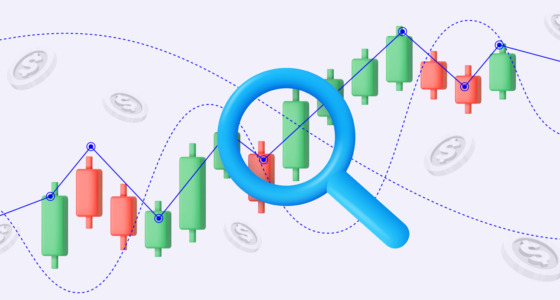

Backtesting is a method for checking a trading strategy using historical price data. This allows traders to determine if a trading strategy is effective before risking real capital. Successful backtesting increases your chance of performing well in the live market and improves confidence. Around 20 million people in India trade — a high number, but only a small percentage of the country’s population of more than 1.2 billion. But trading is steadily increasing in popularity.
As useful as backtesting is, there are many different mistakes traders make when testing a strategy. If you make such errors, the backtesting will not be as useful, since your data will be inaccurate. This in turn could lead you to use a faulty trading strategy, costing you capital.
If you’re thinking about backtesting, you should familiarize yourself with the types of mistakes you might end up making so you can avoid them. This article brings together 10 common mistakes new traders make.
1. Not making a written plan
Writing down a plan is crucial for success. There will inevitably be points where you get swept up in backtesting and forget whatever plan you set beforehand. This is especially true of traders who are new to a strategy and still have to get used to the whole process.
On top of this, some strategies are more complicated than others. When the one you’re trying out has a lot of parameters it can be difficult to keep track of all that’s going on without a written plan.

Make sure you write down everything you need to know for backtesting. Some crucial elements you should make note of are:
- Rules for entry and exit signals
- Your profit target
- Where to set a stop loss
- Your risk per trade percentage
- What indicators you’re using
Depending on the type of strategy you’re testing out, there may be even more points you should make note of. Before you jump straight in with the testing, take a while to determine which parameters you have to be aware of for the trading strategy.
2. Not taking enough trades during testing
Make sure that when you test your strategy you test it against as much historical data as you can. While one particular trading system may have a slight benefit during a relatively short period, like six months, when extended over a longer period it may not be so effective.
Make sure you also take as many trades as you can. You want to make sure that your strategy is reliable in a variety of market conditions. It must be robust, but flexible. The more trades you test your system against, the more accurate a picture you’ll get of your strategy’s strengths and weaknesses.
Optimizing a particular trading system for a specific period of time is known as curve fitting. Make sure to avoid it as best as you can, as it will only get you in trouble later down the line.
3. Quitting a backtest when your results aren’t immediately great
Another common mistake traders make is to give up on a backtest when they don’t see stellar results within just the first few trades. Markets fluctuate and change, and every trading strategy out there sees normal periods of drawdown. You shouldn’t let that discourage you from fully exploring a trading system.
So, if you hit a minor drawdown, don’t just give up on the backtest. Instead, tweak the strategy’s settings to make it work for you. The purpose of backtesting is to improve upon trading systems, not to simply eliminate those that don’t give immediate results.

4. Not sticking to a trading system
Sometimes traders will write down a particular system but then won’t follow its rules at all. As per the first piece of advice in this article, make sure that you write down all the rules of the strategy you’re testing. But, most importantly, make sure you follow them during backtesting.
Make sure that you don’t change the rules of the strategy while you’re in the middle of a trade. Doing this means you won’t have accurate data for your initial system or for the modified version.
5. Believing live results will be the same as backtesting results
Beginner traders may fall into the trap of believing that live trading results will be the same as in backtesting, but that just isn’t the case. Sometimes trading strategies work well in backtesting but don’t perform as well when they’re taken live.
There are several reasons why this might be the case:
- Emotions are involved with live trading. When there’s real capital on the line, you might get stressed or anxious. This could be affecting your trading.
- There might be variables involved in live trading that were not accounted for during your backtesting, such as spreads, the time of day you trade, and factors like economic and political news.
- The market may have shifted significantly since you tested your strategy.
Successful backtesting isn’t necessarily a guarantee you’ll meet success on the live market. While your test will make for a very useful guide, you should remember that market volatility is an inevitable part of live trading.
6. Only testing on one market and believing it will work on others
There may be some trading teachers out there who tell you that their strategy will be successful in any market. It is highly unlikely this is the case.
Every market down to each asset behaves differently. Each market is affected by its own set of factors and changes in the market. There is no one-size-fits-all strategy for trading; there is no one magical system that works for every market.
7. Entering and exiting trades optimally rather than honestly
Entering a trade optimally is the term used for entering a trade at a point where it would fit neatly into your trading plan and bring in the most capital. In real-life trading, not every trade you make will go this smoothly.
Rather than trying to optimize your trades during backtesting, it’s best to follow strict entry rules instead. Resist the urge to go back through the chart looking for the optimum entry point. If you can’t resist this impulse, search for a testing platform that will only let you move forward on trading charts.
8. Giving up on a system because it doesn’t meet monthly return goals
Some traders give up on a trading strategy when it doesn’t consistently meet monthly return goals. In reality, monthly goals are only really feasible for day trading systems. When you’re dealing with time frames greater than that, monthly goals are practically impossible to achieve.
Instead of relying on monthly figures to see how profitable your strategy is, check it against your plan instead.
9. Not considering your strengths when you choose your trading system
Everyone has different skill sets that make some strategies a better fit for them than others. So, when you’re trying to determine what system you’d like to use, be honest with yourself about your capability, your strengths, and your weaknesses.
If you’re not a very patient person, or you need returns quickly, you should avoid long-term trend strategies. On the other hand, if you don’t perform well under stress, you probably wouldn’t enjoy working with high market fluctuations, so stay clear of short-term trend strategies like scalping.
10. Being too afraid to experiment
A final mistake that many new traders make is that they only follow other traders’ rules without experimenting with trading systems for themselves. While it’s certainly very useful to learn about strategies from more experienced traders, you should think of them as starting points more than anything.
Don’t be afraid to adjust a trading system as necessary so that it better fits your personality and schedule. Have fun when you’re backtesting and take the opportunity to try out different ways and ideas.
Final thoughts
This article has looked at 10 mistakes new traders make in backtesting. It’s easy enough to understand why some people slip into these bad habits. But, if you really want to benefit from testing, try your best to avoid these mistakes.
Disclaimer: No strategy can guarantee a 100% correct trade outcome.









